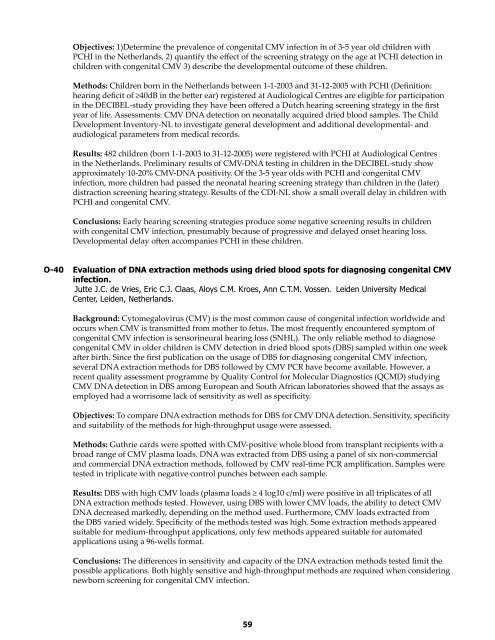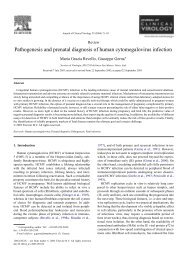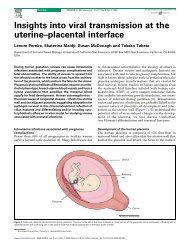Congenital Cytomegalovirus Conference - Congenital CMV ...
Congenital Cytomegalovirus Conference - Congenital CMV ...
Congenital Cytomegalovirus Conference - Congenital CMV ...
You also want an ePaper? Increase the reach of your titles
YUMPU automatically turns print PDFs into web optimized ePapers that Google loves.
Objectives: 1)Determine the prevalence of congenital <strong>CMV</strong> infection in of 3-5 year old children with<br />
PCHI in the Netherlands, 2) quantify the effect of the screening strategy on the age at PCHI detection in<br />
children with congenital <strong>CMV</strong> 3) describe the developmental outcome of these children.<br />
Methods: Children born in the Netherlands between 1-1-2003 and 31-12-2005 with PCHI (Definition:<br />
hearing deficit of ≥40dB in the better ear) registered at Audiological Centres are eligible for participation<br />
in the DECIBEL-study providing they have been offered a Dutch hearing screening strategy in the first<br />
year of life. Assessments: <strong>CMV</strong> DNA detection on neonatally acquired dried blood samples. The Child<br />
Development Inventory-NL to investigate general development and additional developmental- and<br />
audiological parameters from medical records.<br />
Results: 482 children (born 1-1-2003 to 31-12-2005) were registered with PCHI at Audiological Centres<br />
in the Netherlands. Preliminary results of <strong>CMV</strong>-DNA testing in children in the DECIBEL-study show<br />
approximately 10-20% <strong>CMV</strong>-DNA positivity. Of the 3-5 year olds with PCHI and congenital <strong>CMV</strong><br />
infection, more children had passed the neonatal hearing screening strategy than children in the (later)<br />
distraction screening hearing strategy. Results of the CDI-NL show a small overall delay in children with<br />
PCHI and congenital <strong>CMV</strong>.<br />
Conclusions: Early hearing screening strategies produce some negative screening results in children<br />
with congenital <strong>CMV</strong> infection, presumably because of progressive and delayed onset hearing loss.<br />
Developmental delay often accompanies PCHI in these children.<br />
O-40 Evaluation of DNA extraction methods using dried blood spots for diagnosing congenital <strong>CMV</strong><br />
infection.<br />
Jutte J.C. de Vries, Eric C.J. Claas, Aloys C.M. Kroes, Ann C.T.M. Vossen. Leiden University Medical<br />
Center, Leiden, Netherlands.<br />
Background: <strong>Cytomegalovirus</strong> (<strong>CMV</strong>) is the most common cause of congenital infection worldwide and<br />
occurs when <strong>CMV</strong> is transmitted from mother to fetus. The most frequently encountered symptom of<br />
congenital <strong>CMV</strong> infection is sensorineural hearing loss (SNHL). The only reliable method to diagnose<br />
congenital <strong>CMV</strong> in older children is <strong>CMV</strong> detection in dried blood spots (DBS) sampled within one week<br />
after birth. Since the first publication on the usage of DBS for diagnosing congenital <strong>CMV</strong> infection,<br />
several DNA extraction methods for DBS followed by <strong>CMV</strong> PCR have become available. However, a<br />
recent quality assessment programme by Quality Control for Molecular Diagnostics (QCMD) studying<br />
<strong>CMV</strong> DNA detection in DBS among European and South African laboratories showed that the assays as<br />
employed had a worrisome lack of sensitivity as well as specificity.<br />
Objectives: To compare DNA extraction methods for DBS for <strong>CMV</strong> DNA detection. Sensitivity, specificity<br />
and suitability of the methods for high-throughput usage were assessed.<br />
Methods: Guthrie cards were spotted with <strong>CMV</strong>-positive whole blood from transplant recipients with a<br />
broad range of <strong>CMV</strong> plasma loads. DNA was extracted from DBS using a panel of six non-commercial<br />
and commercial DNA extraction methods, followed by <strong>CMV</strong> real-time PCR amplification. Samples were<br />
tested in triplicate with negative control punches between each sample.<br />
Results: DBS with high <strong>CMV</strong> loads (plasma loads ≥ 4 log10 c/ml) were positive in all triplicates of all<br />
DNA extraction methods tested. However, using DBS with lower <strong>CMV</strong> loads, the ability to detect <strong>CMV</strong><br />
DNA decreased markedly, depending on the method used. Furthermore, <strong>CMV</strong> loads extracted from<br />
the DBS varied widely. Specificity of the methods tested was high. Some extraction methods appeared<br />
suitable for medium-throughput applications, only few methods appeared suitable for automated<br />
applications using a 96-wells format.<br />
Conclusions: The differences in sensitivity and capacity of the DNA extraction methods tested limit the<br />
possible applications. Both highly sensitive and high-throughput methods are required when considering<br />
newborn screening for congenital <strong>CMV</strong> infection.<br />
59





